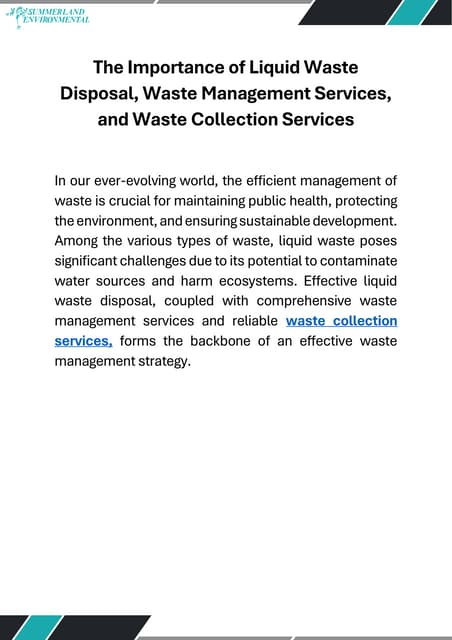Our Reclaim Waste Diaries
Table of ContentsThings about Reclaim WasteGet This Report about Reclaim WasteNot known Facts About Reclaim WasteThe Only Guide for Reclaim WasteIndicators on Reclaim Waste You Should Know
Explore the types, incidents, and types of fluid waste. Residential sewer waste refers to the waste and items from a residential septic system. This sort of waste is developed by human beings in homes, institutions, and various other structures. This only includes septic storage tanks that have a drainpipe area. The appropriate management and disposal of residential sewer waste call for liquid waste to be moved to a sewage therapy plant where the correct methods and devices are used to cleanse and dispose of waste.
Business waste typically includes potential threats, such as combustible products or a mix of liquid and strong waste items, and needs an advanced and in-depth disposal procedure. The disposal of business waste usually includes the purification of waste prior to transport to guarantee risk-free and correct disposal. Hazardous waste is developed from by-products and overflow of commercial processes and production.
This kind of waste can not use the very same sewage management transport or procedures as septic or industrial liquids. The hazardous waste management process calls for the examination and screening of liquid waste prior to it undertakes the disposal procedure (liquid waste disposal). Runoff waste is the fluid waste that originates from runoff and excess stormwater in very populated locations or cities
Runoff waste can trigger contamination and flooding if not dealt with correctly. Guaranteeing appropriate waste administration can protect against catastrophes and lower environmental damage.
Fascination About Reclaim Waste
Contact PROS Services today to find out about our waste administration and disposal solutions and the appropriate methods to take care of the fluid waste you create.
(https://reclaimwaste1.bandcamp.com/album/reclaim-waste)Do you understand what takes place to your water when you draw the plug, purge the commode or drain pipes the washing maker? No? Well, it deserves recognizing. This so-called 'wastewater' is not only a vital source however, after treatment, will certainly be released to our land, rivers or the ocean. Used water from commodes, showers, baths, cooking area sinks, laundries and commercial procedures is referred to as wastewater.

water used to cool down machinery or tidy plant and equipment). Stormwater, a kind of wastewater, is overflow that moves from agricultural and metropolitan locations such as roofings, parks, yards, roads, courses and seamless gutters right into stormwater drains, after rain. Stormwater moves without treatment directly to regional creeks or rivers, at some point reaching the ocean.
The 2-Minute Rule for Reclaim Waste
In Queensland, most wastewater is treated at sewer treatment plants. Wastewater is delivered from residential or commercial websites through a system of sewers and pump stations, understood as sewage reticulation, to a sewer treatment plant.
The Division of Natural Resources suggests city governments about handling, operating and preserving sewage systems and therapy plants. In unsewered areas, neighborhood governments may call for owners to mount private or family sewage treatment systems to treat residential wastewater from commodes, kitchen areas, restrooms and washings. The Department of Natural Resources authorises using household systems when they are shown to be reliable.
The majority of stormwater receives no treatment. In some new class, therapy of some stormwater to eliminate clutter, sand and gravel has started using gross toxin catches. Wastewater therapy happens in 4 stages: Removes strong matter. Larger solids, such as plastics and other objects mistakenly discharged to sewers, are gotten rid of when wastewater is passed with displays.
Makes use of tiny living organisms recognizes as micro-organisms to break down and eliminate staying liquified wastes and fine bits. Micro-organisms and wastes are included in the sludge.
The Ultimate Guide To Reclaim Waste
Nutrient removal is not offered in all sewage therapy plants because it requires pricey specialist equipment. It is becoming extra common in Queensland. Clear liquid effluent produced after therapy might still have disease-causing micro-organisms. If this effluent is released into waterways such as rivers or the sea, the micro-organisms will eventually die out.

This generally implies wastewater has actually to be dealt with or impurities eliminated before it can be discharged to rivers. The majority of wastewater moves into the sewerage system. Under the Act, neighborhood federal governments provide approvals and permits for ecologically appropriate tasks (Periods) involving wastewater releases that might have a regional impact. The division provides approvals and licences to ERAs involving wastewater launches that might have a local or statewide effect.
The 20-Second Trick For Reclaim Waste
Otherwise, examples are considered lab analysis. Usually several examinations are required to establish the degrees of each of the various contaminants such as oils, heavy steels and chemicals in water. Surveillance provides valid information concerning water quality and can confirm that licence conditions are being satisfied. The details obtained via monitoring provides the basis for making water high quality decisions.